Page 328 of 615
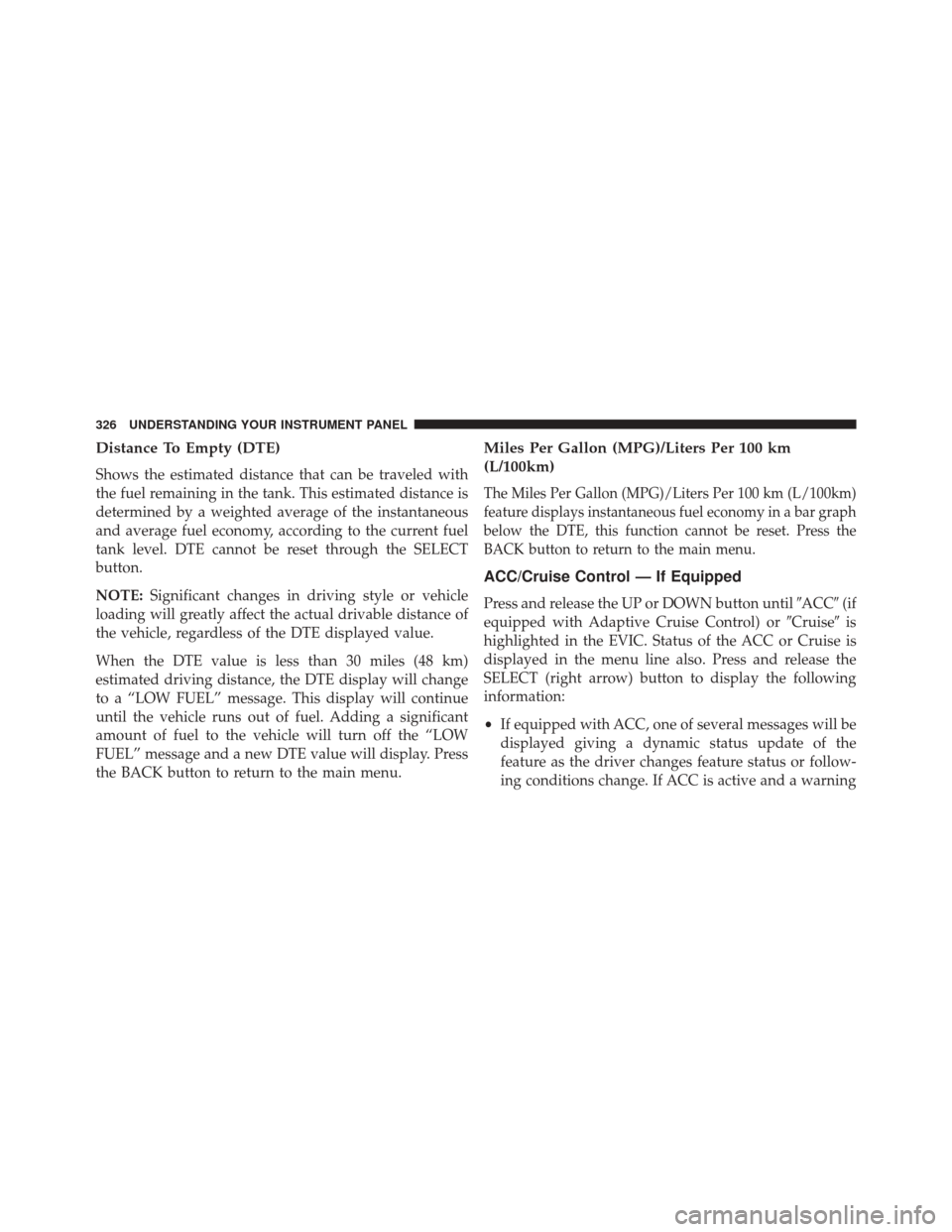
Distance To Empty (DTE)
Shows the estimated distance that can be traveled with
the fuel remaining in the tank. This estimated distance is
determined by a weighted average of the instantaneous
and average fuel economy, according to the current fuel
tank level. DTE cannot be reset through the SELECT
button.
NOTE:Significant changes in driving style or vehicle
loading will greatly affect the actual drivable distance of
the vehicle, regardless of the DTE displayed value.
When the DTE value is less than 30 miles (48 km)
estimated driving distance, the DTE display will change
to a “LOW FUEL” message. This display will continue
until the vehicle runs out of fuel. Adding a significant
amount of fuel to the vehicle will turn off the “LOW
FUEL” message and a new DTE value will display. Press
the BACK button to return to the main menu.
Miles Per Gallon (MPG)/Liters Per 100 km
(L/100km)
The Miles Per Gallon (MPG)/Liters Per 100 km (L/100km)
feature displays instantaneous fuel economy in a bar graph
below the DTE, this function cannot be reset. Press the
BACK button to return to the main menu.
ACC/Cruise Control — If Equipped
Press and release the UP or DOWN button until �ACC�(if
equipped with Adaptive Cruise Control) or �Cruise�is
highlighted in the EVIC. Status of the ACC or Cruise is
displayed in the menu line also. Press and release the
SELECT (right arrow) button to display the following
information:
• If equipped with ACC, one of several messages will be
displayed giving a dynamic status update of the
feature as the driver changes feature status or follow-
ing conditions change. If ACC is active and a warning
326 UNDERSTANDING YOUR INSTRUMENT PANEL
Page 335 of 615
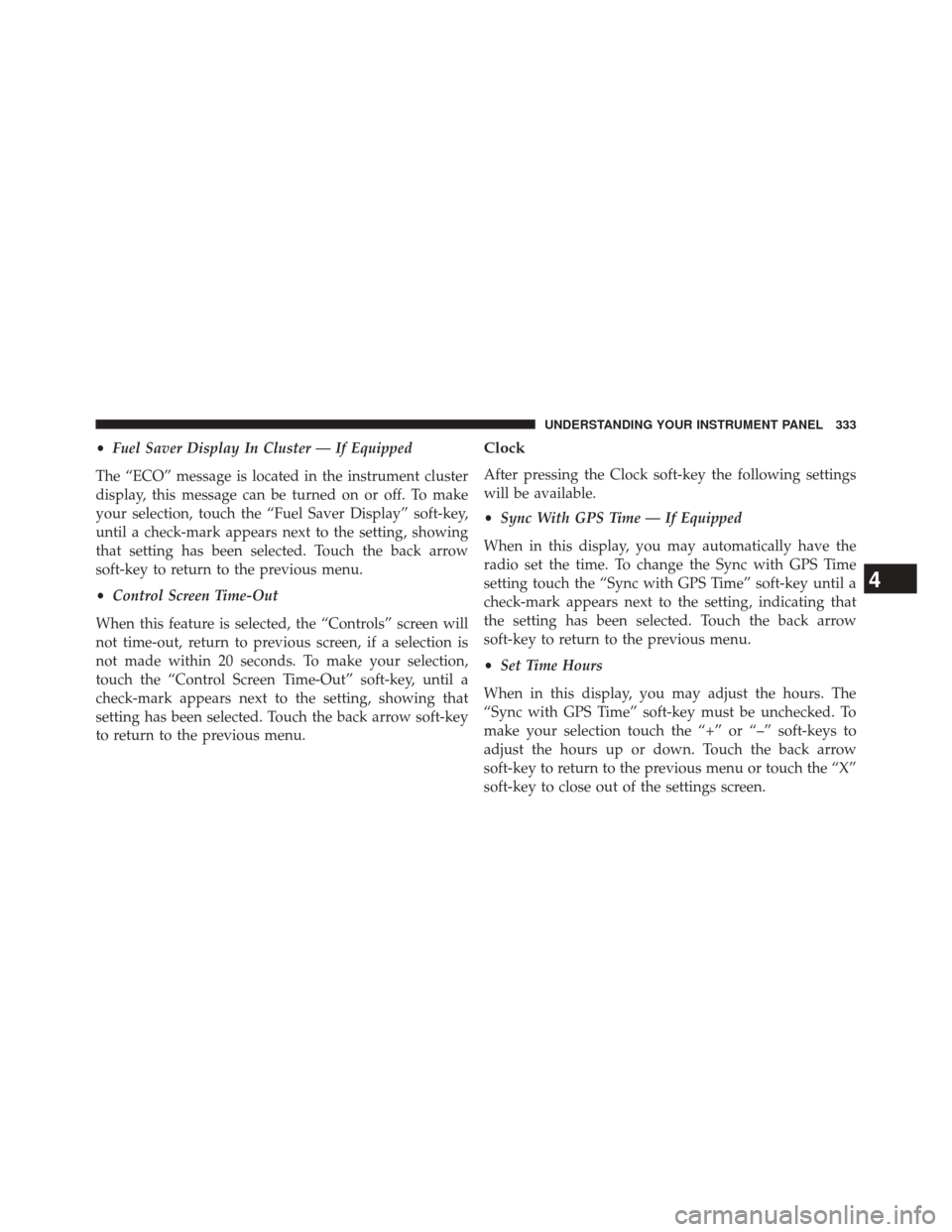
•Fuel Saver Display In Cluster — If Equipped
The “ECO” message is located in the instrument cluster
display, this message can be turned on or off. To make
your selection, touch the “Fuel Saver Display” soft-key,
until a check-mark appears next to the setting, showing
that setting has been selected. Touch the back arrow
soft-key to return to the previous menu.
• Control Screen Time-Out
When this feature is selected, the “Controls” screen will
not time-out, return to previous screen, if a selection is
not made within 20 seconds. To make your selection,
touch the “Control Screen Time-Out” soft-key, until a
check-mark appears next to the setting, showing that
setting has been selected. Touch the back arrow soft-key
to return to the previous menu.Clock
After pressing the Clock soft-key the following settings
will be available.
• Sync With GPS Time — If Equipped
When in this display, you may automatically have the
radio set the time. To change the Sync with GPS Time
setting touch the “Sync with GPS Time” soft-key until a
check-mark appears next to the setting, indicating that
the setting has been selected. Touch the back arrow
soft-key to return to the previous menu.
• Set Time Hours
When in this display, you may adjust the hours. The
“Sync with GPS Time” soft-key must be unchecked. To
make your selection touch the “+” or “–” soft-keys to
adjust the hours up or down. Touch the back arrow
soft-key to return to the previous menu or touch the “X”
soft-key to close out of the settings screen.
4
UNDERSTANDING YOUR INSTRUMENT PANEL 333
Page 358 of 615
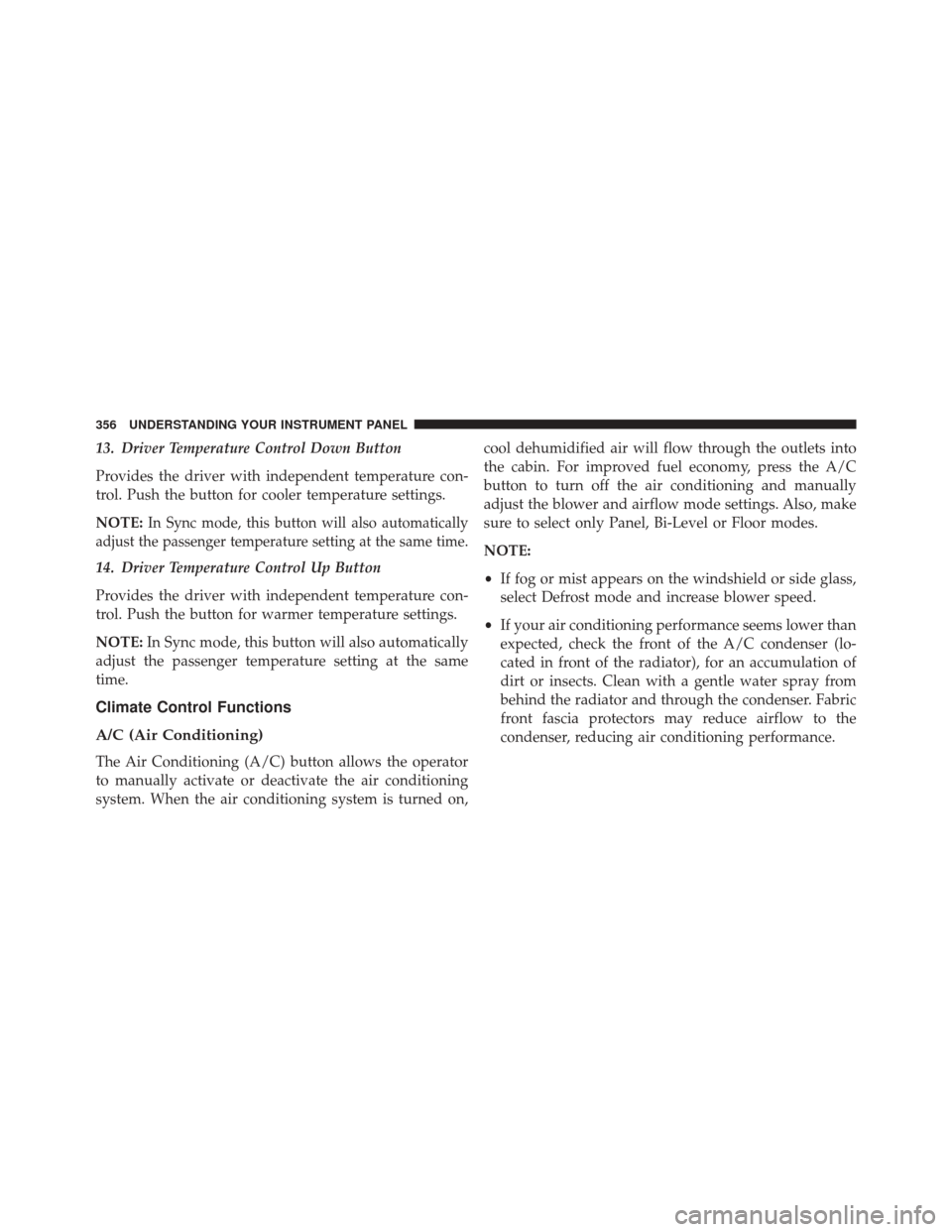
13. Driver Temperature Control Down Button
Provides the driver with independent temperature con-
trol. Push the button for cooler temperature settings.
NOTE:
In Sync mode, this button will also automatically
adjust the passenger temperature setting at the same time.
14. Driver Temperature Control Up Button
Provides the driver with independent temperature con-
trol. Push the button for warmer temperature settings.
NOTE: In Sync mode, this button will also automatically
adjust the passenger temperature setting at the same
time.
Climate Control Functions
A/C (Air Conditioning)
The Air Conditioning (A/C) button allows the operator
to manually activate or deactivate the air conditioning
system. When the air conditioning system is turned on, cool dehumidified air will flow through the outlets into
the cabin. For improved fuel economy, press the A/C
button to turn off the air conditioning and manually
adjust the blower and airflow mode settings. Also, make
sure to select only Panel, Bi-Level or Floor modes.
NOTE:
•
If fog or mist appears on the windshield or side glass,
select Defrost mode and increase blower speed.
• If your air conditioning performance seems lower than
expected, check the front of the A/C condenser (lo-
cated in front of the radiator), for an accumulation of
dirt or insects. Clean with a gentle water spray from
behind the radiator and through the condenser. Fabric
front fascia protectors may reduce airflow to the
condenser, reducing air conditioning performance.
356 UNDERSTANDING YOUR INSTRUMENT PANEL
Page 364 of 615
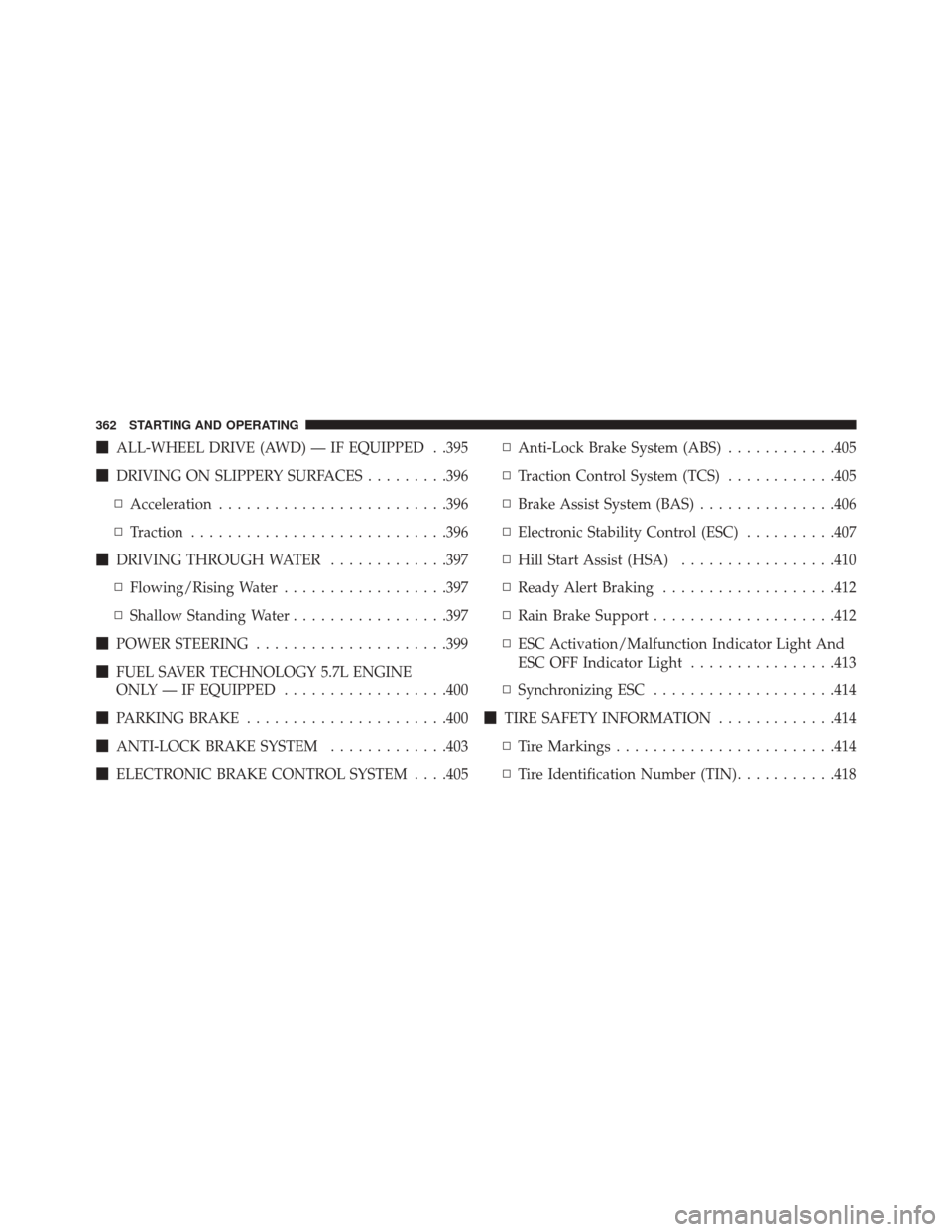
�ALL-WHEEL DRIVE (AWD) — IF EQUIPPED . .395
� DRIVING ON SLIPPERY SURFACES .........396
▫ Acceleration ........................ .396
▫ Traction ........................... .396
� DRIVING THROUGH WATER .............397
▫ Flowing/Rising Water ..................397
▫ Shallow Standing Water .................397
� POWER STEERING .....................399
� FUEL SAVER TECHNOLOGY 5.7L ENGINE
ONLY — IF EQUIPPED ..................400
� PARKING BRAKE ..................... .400
� ANTI-LOCK BRAKE SYSTEM .............403
� ELECTRONIC BRAKE CONTROL SYSTEM . . . .405 ▫
Anti-Lock Brake System (ABS) ............405
▫ Traction Control System (TCS) ............405
▫ Brake Assist System (BAS) ...............406
▫ Electronic Stability Control (ESC) ..........407
▫ Hill Start Assist (HSA) .................410
▫ Ready Alert Braking ...................412
▫ Rain Brake Support ....................412
▫ ESC Activation/Malfunction Indicator Light And
ESC OFF Indicator Light ................413
▫ Synchronizing ESC ....................414
� TIRE SAFETY INFORMATION .............414
▫ Tire Markings ....................... .414
▫ Tire Identification Number (TIN) ...........418
362 STARTING AND OPERATING
Page 365 of 615
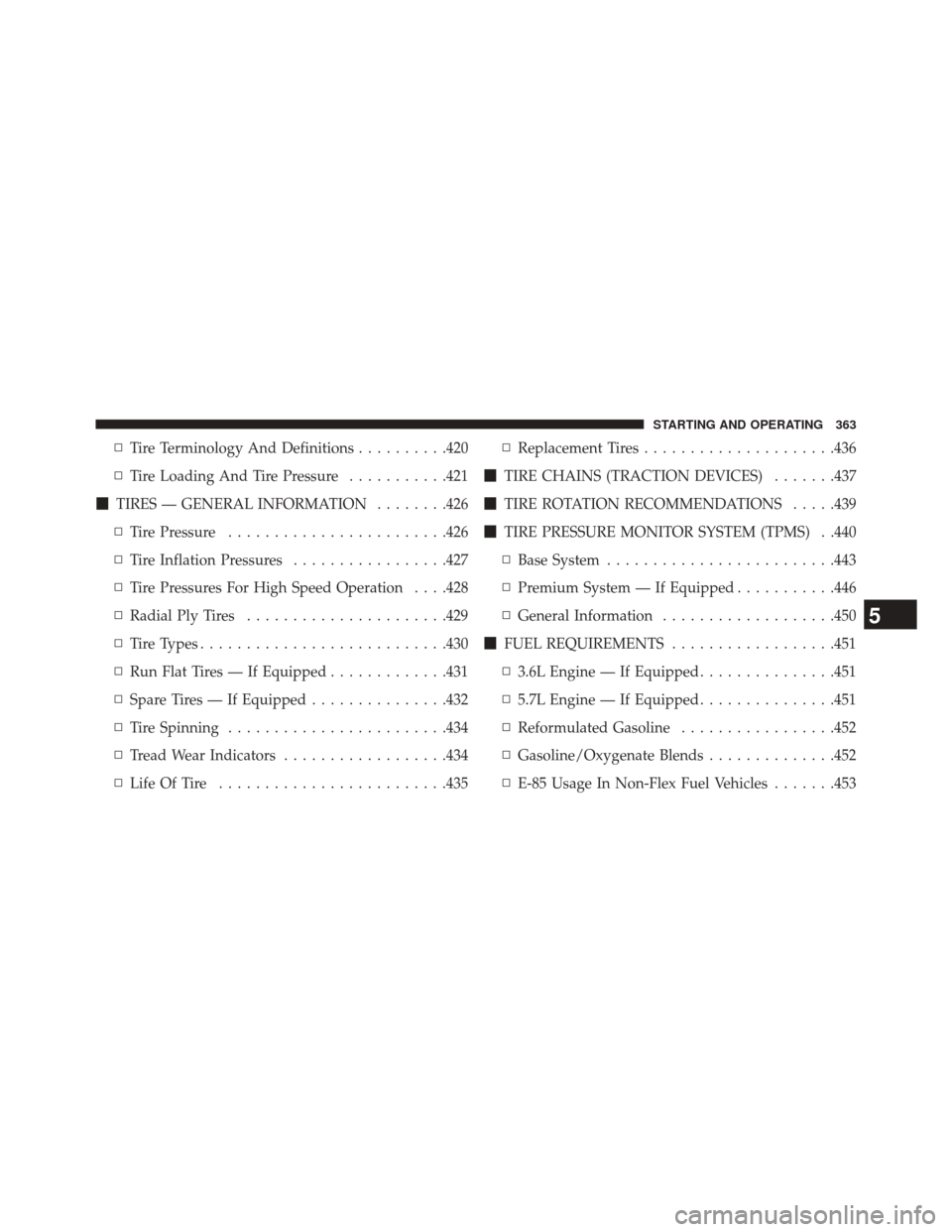
▫Tire Terminology And Definitions ..........420
▫ Tire Loading And Tire Pressure ...........421
� TIRES — GENERAL INFORMATION ........426
▫ Tire Pressure ....................... .426
▫ Tire Inflation Pressures .................427
▫ Tire Pressures For High Speed Operation . . . .428
▫ Radial Ply Tires ..................... .429
▫ Tire Types .......................... .430
▫ Run Flat Tires — If Equipped .............431
▫ Spare Tires — If Equipped ...............432
▫ Tire Spinning ....................... .434
▫ Tread Wear Indicators ..................434
▫ Life Of Tire ........................ .435▫
Replacement Tires .....................436
� TIRE CHAINS (TRACTION DEVICES) .......437
� TIRE ROTATION RECOMMENDATIONS .....439
� TIRE PRESSURE MONITOR SYSTEM (TPMS) . .440
▫ Base System ........................ .443
▫ Premium System — If Equipped ...........446
▫ General Information ...................450
� FUEL REQUIREMENTS ..................451
▫ 3.6L Engine — If Equipped ...............451
▫ 5.7L Engine — If Equipped ...............451
▫ Reformulated Gasoline .................452
▫ Gasoline/Oxygenate Blends ..............452
▫ E-85 Usage In Non-Flex Fuel Vehicles .......453
5
STARTING AND OPERATING 363
Page 366 of 615
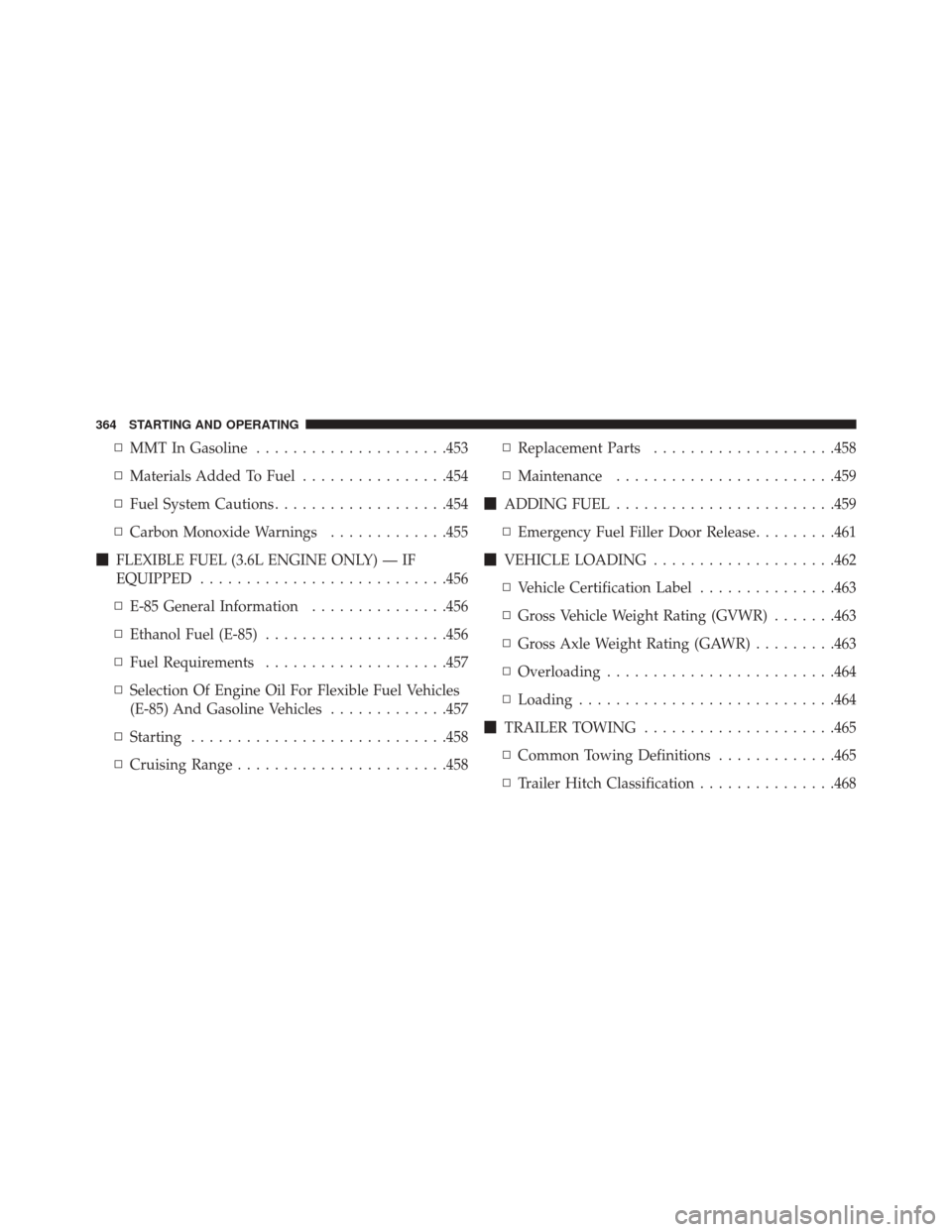
▫MMT In Gasoline .....................453
▫ Materials Added To Fuel ................454
▫ Fuel System Cautions ...................454
▫ Carbon Monoxide Warnings .............455
� FLEXIBLE FUEL (3.6L ENGINE ONLY) — IF
EQUIPPED .......................... .456
▫ E-85 General Information ...............456
▫ Ethanol Fuel (E-85) ....................456
▫ Fuel Requirements ....................457
▫ Selection Of Engine Oil For Flexible Fuel Vehicles
(E-85) And Gasoline Vehicles .............457
▫ Starting ........................... .458
▫ Cruising Range ...................... .458▫
Replacement Parts ....................458
▫ Maintenance ....................... .459
� ADDING FUEL ....................... .459
▫ Emergency Fuel Filler Door Release .........461
� VEHICLE LOADING ....................462
▫ Vehicle Certification Label ...............463
▫ Gross Vehicle Weight Rating (GVWR) .......463
▫ Gross Axle Weight Rating (GAWR) .........463
▫ Overloading ........................ .464
▫ Loading ........................... .464
� TRAILER TOWING .....................465
▫ Common Towing Definitions .............465
▫ Trailer Hitch Classification ...............468
364 STARTING AND OPERATING
Page 371 of 615
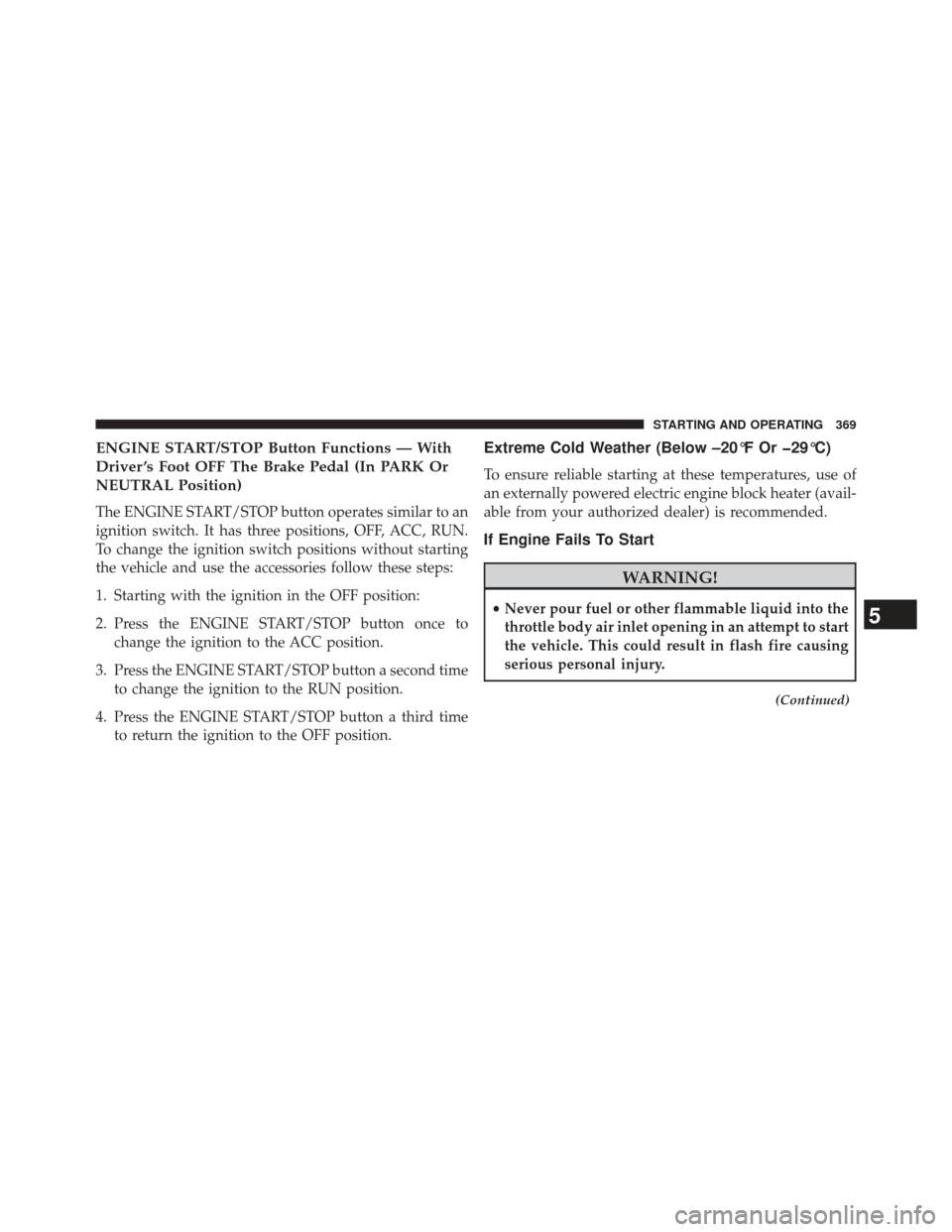
ENGINE START/STOP Button Functions — With
Driver ’s Foot OFF The Brake Pedal (In PARK Or
NEUTRAL Position)
The ENGINE START/STOP button operates similar to an
ignition switch. It has three positions, OFF, ACC, RUN.
To change the ignition switch positions without starting
the vehicle and use the accessories follow these steps:
1. Starting with the ignition in the OFF position:
2. Press the ENGINE START/STOP button once tochange the ignition to the ACC position.
3. Press the ENGINE START/STOP button a second time to change the ignition to the RUN position.
4. Press the ENGINE START/STOP button a third time to return the ignition to the OFF position.
Extreme Cold Weather (Below –20°F Or �29°C)
To ensure reliable starting at these temperatures, use of
an externally powered electric engine block heater (avail-
able from your authorized dealer) is recommended.
If Engine Fails To Start
WARNING!
•Never pour fuel or other flammable liquid into the
throttle body air inlet opening in an attempt to start
the vehicle. This could result in flash fire causing
serious personal injury.
(Continued)
5
STARTING AND OPERATING 369
Page 372 of 615
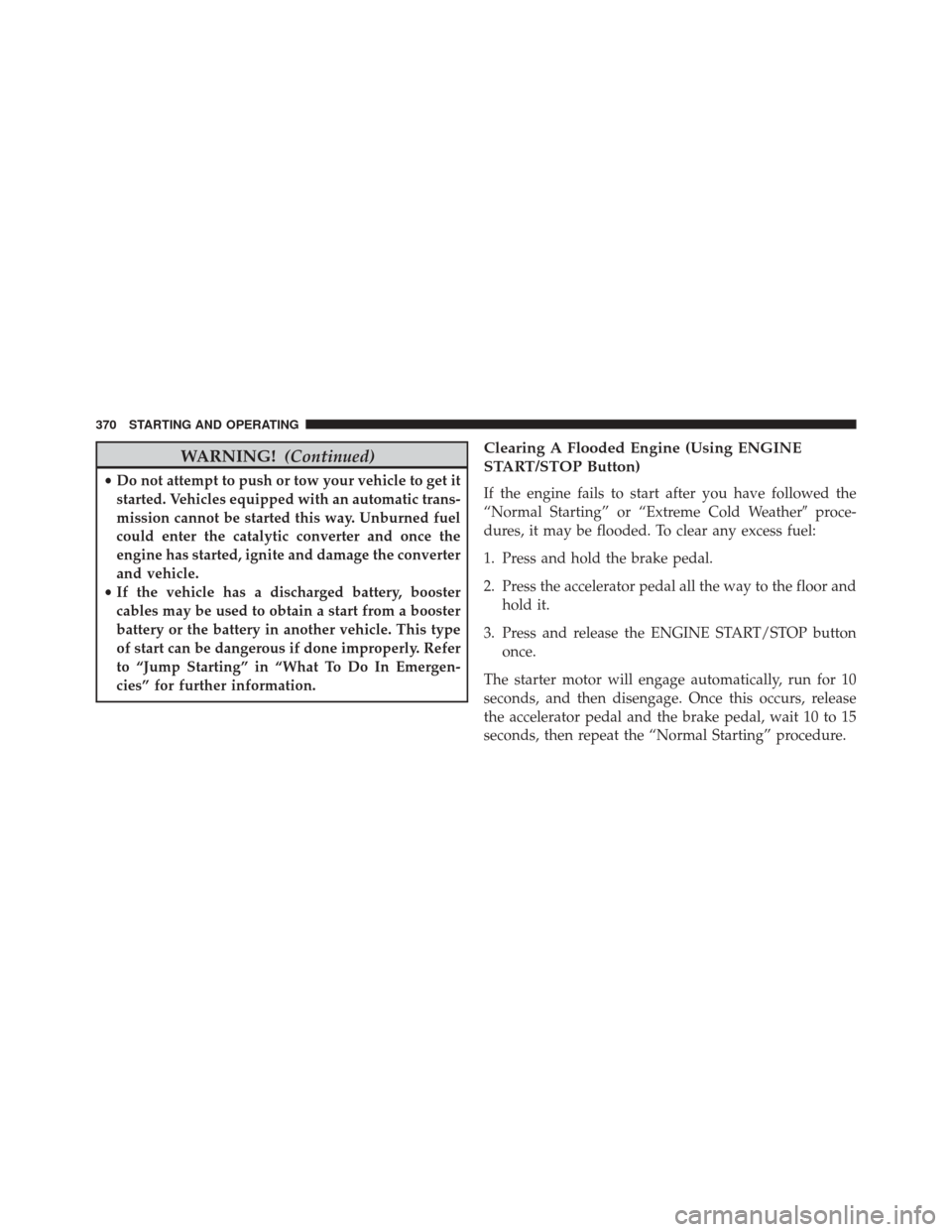
WARNING!(Continued)
•Do not attempt to push or tow your vehicle to get it
started. Vehicles equipped with an automatic trans-
mission cannot be started this way. Unburned fuel
could enter the catalytic converter and once the
engine has started, ignite and damage the converter
and vehicle.
• If the vehicle has a discharged battery, booster
cables may be used to obtain a start from a booster
battery or the battery in another vehicle. This type
of start can be dangerous if done improperly. Refer
to “Jump Starting” in “What To Do In Emergen-
cies” for further information.
Clearing A Flooded Engine (Using ENGINE
START/STOP Button)
If the engine fails to start after you have followed the
“Normal Starting” or “Extreme Cold Weather� proce-
dures, it may be flooded. To clear any excess fuel:
1. Press and hold the brake pedal.
2. Press the accelerator pedal all the way to the floor and hold it.
3. Press and release the ENGINE START/STOP button once.
The starter motor will engage automatically, run for 10
seconds, and then disengage. Once this occurs, release
the accelerator pedal and the brake pedal, wait 10 to 15
seconds, then repeat the “Normal Starting” procedure.
370 STARTING AND OPERATING